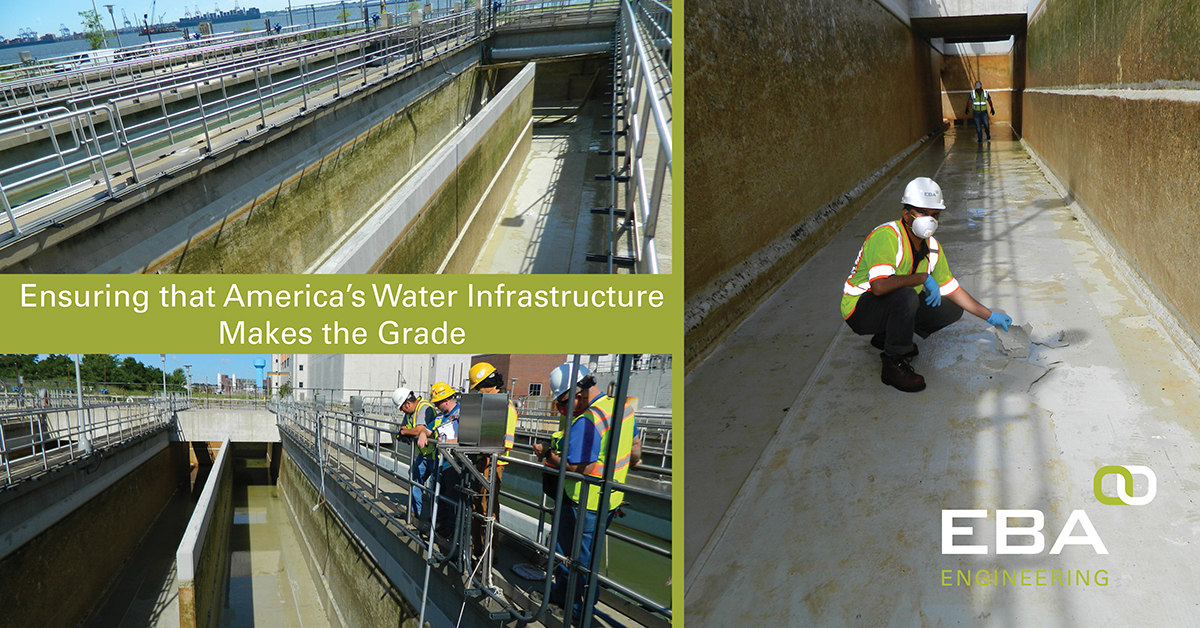Ensuring that America’s Water Infrastructure Makes the Grade

According to United for Infrastructure, most Americans’ water systems have been in operation for 75 to 100 years—well past their intended lifespans. The threat of the nation’s crumbling water and wastewater infrastructure is sadly becoming more and more apparent. In Florida, for example, untreated sewage entering waterways has contributed to blue-green algae blooms causing big problems in Florida’s estuaries and worsened red tide in the Gulf of Mexico.
EBA’s Prakas Karattukudy, PE, PMP, has previously written about the dangers of America’s failing utility systems and other critical infrastructure from delayed maintenance and underinvestment. In the American Society of Civil Engineers’ (ASCE) most recent Infrastructure Report Card, the nation’s wastewater infrastructure received a nearly failing D+ rating.
“The majority of the nation’s WWTPs are designed with an average lifespan of 40 to 50 years, so the systems that were constructed in the 1970s, around the passing of the Clean Water Act in 1972, are reaching the end of their service lives,” says ASCE.
Knowing the importance of maintaining and upgrading America’s aging water and wastewater infrastructure, I truly appreciate being part of rehabilitation projects aimed at protecting citizens and the environment—projects like the Patapsco Wastewater Treatment Plant (WWTP) chlorine contact chamber renovation.
Originally constructed in 1940, the Patapsco WWTP is part of the City of Baltimore’s critical water infrastructure. The plant has a capacity of 63 million gallons per day and serves an area of approximately 184 square miles.
Maintaining facilities like the Patapsco WWTP is not only important for the nearly half a million people it serves but also to protect the environment from contaminated wastewater discharges. The plant’s goal is to remove pollutants from the incoming wastewater received daily and return it to the environment without harming aquatic life in the Patapsco River and Chesapeake Bay.
One of the last steps in the wastewater treatment process at Patapsco is chlorinating the wastewater, which occurs in four different chambers. Because chlorine had attached on the concrete substrate over time, causing surface erosion, the basins had deteriorated severely. The chambers also showed signs of baffle wall failures and mechanical equipment corrosion—in all, a recipe for a potential disaster.
The City undertook a repair and rehabilitation project to repair all four chlorine chambers, including repairing and finishing more than 160,000 square feet of concrete surface and then coating it with a chemical resistant epoxy. The product used to coat the chambers can now be cleaned easily and is abrasion resistant for long-term wear. The team successfully repaired all large cracks and spalls using high performance mortar, repoured and reinforced the baffle walls, and removed and replaced all expansion joint material with a chemical resistant material.
EBA Engineering, Inc. (EBA) was the engineer of record for the chamber renovation project, which lasted over a year. EBA inspected the four chlorine contact chambers to identify the structural defects and selected repair techniques and materials to stabilize the concrete, reconstruct the baffle walls, and replace the mechanical and metal fixtures.
After 1 year of service, a follow-up inspection concluded that the coating was in excellent condition and any residue could be easily wiped off.
These types of projects are difficult to plan, and implementing them correctly is crucial to ensuring a lasting repair. Since the adjacent chambers remained in service at the Patapsco WWTP during repairs, one big project challenge was diverting water to protect the work areas and maintain dry curing conditions. Moisture was also a concern when replacing the expansion joint material and applying the chemical resistant epoxy coating to the chamber walls.
In spite of the challenges, this type of investment in renovating and rehabilitating America’s aging infrastructure will be key to building a safer and more resilient future.
